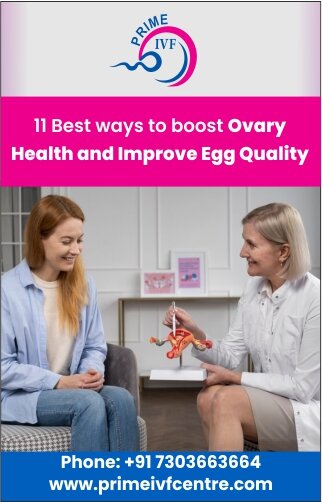How Is Azoospermia Treated? Know Your Options

- 17 Apr, 2024
- IVF and Infertility
- infertility
- Medically Reviewed By:
 Dr. Nishi Singh
Dr. Nishi Singh - Author: Prime IVF Centre
If you or someone you know has been diagnosed with azoospermia, you may be wondering about the available treatment options. Azoospermia, a condition where a man doesn't have any sperm in his semen, can be a challenging diagnosis for couples hoping to conceive. However, understanding the azoospermia treatment options available can provide hope and guidance on the path to parenthood.
Table Of Content
Treatment Options for Azoospermia
Lifestyle Modifications and Supportive Therapies
Future Directions in Azoospermia Treatment
What is Azoospermia?
Azoospermia is a condition where there is an absence of sperm in the ejaculate. It has two main subtypes: obstructive and non-obstructive. Obstructive azoospermia occurs due to blockages in the reproductive tract, preventing sperm from reaching the semen. Non-obstructive azoospermia happens when the testicles are unable to produce sperm. This condition significantly affects male fertility, as sperm is necessary for fertilizing an egg and achieving pregnancy.
Common causes of azoospermia include genetic factors, hormonal imbalances, infections, and lifestyle factors like smoking and excessive alcohol consumption. These factors can disrupt the production, transport, or maturation of sperm, leading to the absence of sperm in the ejaculate and infertility issues for affected individuals.
Diagnosing Azoospermia
Diagnosing azoospermia involves several steps to accurately determine the underlying cause of the condition:
- Medical History: Your healthcare provider will ask detailed questions about your medical history, including any previous surgeries, illnesses, or medications that may impact fertility.
- Physical Examination: A thorough physical examination, including examination of the genitals and reproductive organs, may help identify any physical abnormalities or signs of underlying health conditions.
- Semen Analysis: A semen analysis is a crucial diagnostic test that evaluates the quantity, quality, and motility of sperm in the ejaculate. Azoospermia is confirmed if no sperm are found in the semen sample.
Additional tests may be recommended to further evaluate the cause of azoospermia:
- Hormonal Assays: Blood tests may be performed to measure hormone levels, such as testosterone, follicle-stimulating hormone (FSH), and luteinizing hormone (LH), which can provide insight into hormonal imbalances that may contribute to infertility.
- Genetic Testing: Genetic testing may be recommended to identify any underlying genetic abnormalities or conditions that affect sperm production or function.
- Testicular Biopsy: In some cases, a testicular biopsy may be performed to obtain a tissue sample from the testicles for further examination. This procedure can help identify issues such as obstructive vs. non-obstructive azoospermia and determine the presence of sperm within the testicular tissue.
Early and thorough diagnostic evaluation is crucial for optimizing fertility outcomes and guiding treatment decisions.
Treatment Options for Azoospermia
When it comes to azoospermia treatment, understanding the available options is essential for individuals and couples seeking to overcome male infertility. A variety of treatment options exist to address both obstructive and non-obstructive forms of azoospermia:
a. Obstructive Azoospermia
In cases of obstructive azoospermia, surgical interventions can help restore fertility:
- Vasectomy Reversal: This procedure reconnects the vas deferens, allowing sperm to once again travel from the testicles to the ejaculatory duct. It is a highly effective option for men who have undergone a vasectomy and wish to restore fertility.
- Epididymal or Testicular Sperm Retrieval Techniques: In cases where vasectomy reversal is not feasible or unsuccessful, sperm can be directly retrieved from the epididymis or testicles using minimally invasive surgical techniques. These retrieved sperm can then be used for assisted reproductive procedures such as IVF-ICSI.
Success Rates and Risks
Success rates of Vasectomy Reversal vary but can be as high as 90% in cases where the vasectomy was performed recently. However, success rates may decrease over time, particularly if a significant amount of time has passed since the vasectomy.
In case of Epididymal or Testicular Sperm Retrieval, success rates vary depending on factors such as the underlying cause of obstruction and the skill of the surgeon. Risks associated with these procedures include bleeding, infection, and damage to surrounding tissues. However, complications are rare, and most men recover without long-term issues.
b. Non-Obstructive Azoospermia
Options for non-obstructive azoospermia treatment include medical interventions and assisted reproductive techniques (ART).
Hormone Therapy
Hormonal imbalances can contribute to non-obstructive azoospermia. Hormone therapy, which involves the administration of medications to regulate hormone levels, may be prescribed to stimulate sperm production in the testicles. Success rates of hormone therapy vary depending on individual factors such as the severity of the hormonal imbalance and overall health.
Assisted Reproductive Techniques (ART)
In Vitro Fertilization (IVF) with Intracytoplasmic Sperm Injection (ICSI): IVF-ICSI involves fertilizing an egg with a single sperm injected directly into the egg. This technique bypasses the need for sperm to travel through the reproductive tract and is highly effective in cases of severe male factor infertility. Success rates of IVF-ICSI can be influenced by factors such as the quality of the eggs and the overall health of the woman undergoing the procedure.
Donor Sperm and Adoption
In cases where other treatment options are unsuccessful or not feasible, donor sperm can be used for assisted reproductive procedures such as IVF-ICSI. Donor sperm offers a viable alternative for couples struggling with male infertility.
Lifestyle Modifications and Supportive Therapies
Simple yet impactful lifestyle changes can positively influence sperm quality and overall reproductive health:
- Maintaining a Healthy Weight: Achieving and maintaining a healthy weight through balanced diet and regular exercise is essential for optimal fertility. Excess body weight can disrupt hormone levels and sperm production, while being underweight may also affect fertility. Aim for a healthy body mass index (BMI) to optimize fertility potential.
- Quitting Smoking: Smoking tobacco has been linked to decreased sperm count, motility, and morphology. Quitting smoking can improve sperm quality and overall reproductive health, increasing the chances of conception.
- Reducing Alcohol Consumption: Excessive alcohol consumption can negatively impact sperm quality and fertility. Limit alcohol intake to moderate levels or abstain from alcohol altogether to support optimal reproductive function.
Coping with a diagnosis of azoospermia and undergoing treatment can be emotionally challenging for individuals and couples. Seeking support from counseling and support groups can provide valuable support:
- Counseling: Professional counseling can help individuals and couples navigate the emotional impact of infertility. Counseling sessions may address feelings of grief, anxiety, depression, and stress associated with infertility diagnosis and nil sperm count treatment. By exploring coping strategies and developing effective communication skills, counseling can help individuals and couples strengthen their relationship and resilience during this challenging time.
- Support Groups: Joining support groups for individuals and couples facing infertility can provide a sense of community and belonging. Sharing experiences, thoughts, and feelings with others who understand can reduce feelings of isolation and provide valuable insights and encouragement.
Future Directions in Azoospermia Treatment
Ongoing research in reproductive medicine continues to explore new therapies and advancements aimed at improving fertility outcomes for individuals with azoospermia. Emerging treatments may include innovative gene therapies, stem cell-based approaches, and advanced techniques for sperm production and maturation. It's essential for individuals and couples affected by azoospermia to stay informed about these advancements and consult with azoospermia specialist to explore the most promising treatment options for their unique circumstances.
Conclusion
Navigating azoospermia and exploring treatment options can be challenging, but it's important to remain hopeful and informed. By understanding the available treatments, individuals and couples can take proactive steps towards building their family. Lifestyle modifications and emotional support also play crucial roles in the fertility journey. As advancements in reproductive medicine continue, there is reason to remain optimistic about future treatment options. For personalized guidance and support on your fertility journey, consider consulting with experts at Prime IVF Centre. Contact Prime IVF Centre today to schedule a consultation and explore your options for overcoming azoospermia under best azoospermia treatment cost and achieving your dream of parenthood.
FAQs
What are the options for azoospermia?
Options for azoospermia include hormonal therapy, surgical sperm retrieval, and assisted reproductive techniques like IVF with donor sperm.
How do I know what type of azoospermia I have?
Types of azoospermia include obstructive and non-obstructive. Diagnosis is made through physical exams, hormone tests, and imaging studies.
Which type of azoospermia is not treatable?
Non-obstructive azoospermia may be untreatable if testicular function is severely impaired, but options like sperm donation exist.
What are the next steps for azoospermia?
Next steps for azoospermia involve consulting a urologist or fertility specialist, undergoing diagnostic tests, and considering treatment options.
Is there hope for azoospermia?
Hope for azoospermia exists through advances in reproductive medicine, such as surgical techniques and assisted reproductive technologies.

